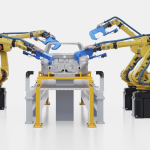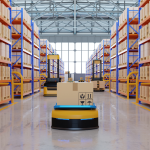The trucking industry is undergoing a structural shift. Rising operational costs, driver shortages, and increasing supply chain complexity are forcing logistics providers to rethink how they optimize networks, allocate resources, and make real-time decisions. Traditional approaches, reliant on manual processes and siloed data, are struggling to keep pace.
As logistics networks become more interconnected, the ability to leverage artificial intelligence to make smarter, faster decisions is becoming a key differentiator. According to a recent study from Gartner, by 2026, 30 percent of enterprises will have automated more than half of their network activities, up from less than 10 percent in mid-2023. AI is no longer just improving efficiencies—it is actively reshaping how companies manage fleets, routes, and overall business strategy.
Rethinking Logistics from a Decision-Centric Perspective
For decades, trucking operations have been defined by incremental improvements: better route optimization, more advanced fleet tracking, and streamlined workflows. Yet, despite these advancements, decision-making has remained largely reactive. Managers rely on a combination of experience, historical trends, and limited real-time data, leaving supply chains vulnerable to unexpected disruptions.
The next evolution of trucking isn’t about simply automating existing workflows—it’s about reengineering decision-making itself. AI-driven decision intelligence allows companies to process vast amounts of data in real time, optimizing fleet assignments, load balancing, and resource allocation dynamically. Instead of adjusting schedules after delays occur, AI anticipates bottlenecks before they emerge, adapting routes and redistributing capacity based on evolving conditions.
From Isolated Operations to a Unified Intelligence Network
One of the most persistent inefficiencies in logistics is the fragmented nature of decision-making. Traditional trucking operations often divide planning by region, with separate teams managing dispatch, fleet coordination, and brokerage. These silos limit visibility, creating inefficiencies such as empty miles, inconsistent load assignments, and suboptimal asset utilization.
AI-driven decision intelligence eliminates these blind spots by unifying data across the entire network. Rather than relying on individual planners making isolated decisions, AI enables companies to coordinate fleets dynamically, optimizing vehicle movements based on network-wide supply and demand. This shift allows for better load matching, reduced dwell times, and an overall increase in asset efficiency.
Companies that integrate AI-powered decision intelligence into their networks are not just improving logistics workflows—they are fundamentally changing how capacity is managed, reducing dependency on reactive planning and enabling real-time adaptability.
Beyond Efficiency: How AI is Reshaping the Driver Experience
Much of the industry conversation around AI has focused on operational efficiencies, but a less discussed—and equally important—impact is its ability to improve driver satisfaction and retention.
Many drivers experience frustration when dispatch decisions are made in isolation, forcing them onto inefficient routes or assigning loads that do not align with their availability or preferences. Poor coordination between planners and network-wide decision-making leads to unnecessary downtime, reduced earnings, and higher turnover rates.
AI helps bridge this gap by ensuring that routing decisions factor in driver experience, availability, and long-term efficiency rather than just immediate load fulfillment. Instead of being treated as an afterthought, drivers benefit from an intelligent, data-driven system that prioritizes fair distribution of loads, minimizes wasted time, and provides greater transparency into scheduling decisions.
Companies that optimize driver utilization not only improve efficiency but also strengthen retention, reducing turnover costs and ensuring a more stable workforce. AI-driven fleet coordination ensures that trucking remains a viable, rewarding career, rather than a profession bogged down by inefficiencies and unpredictability.
The Competitive Edge of AI in Logistics
Trucking companies that still rely on manual planning and human-driven decision-making are at an increasing disadvantage. The ability to integrate AI-powered intelligence into logistics strategy is no longer a luxury—it is a necessity for long-term competitiveness.
Companies that invest in AI-driven optimization see higher asset utilization, reduced operational costs, and better network flexibility. Those that continue operating with traditional planning methods risk falling behind in an industry that is becoming more data-driven, interconnected, and responsive to real-time challenges.
The future of trucking isn’t just about automation—it’s about intelligence-driven adaptability. Companies that successfully integrate AI into their operations will be positioned to lead in a rapidly evolving logistics landscape, where decision-making is faster, smarter, and more strategic than ever before.







